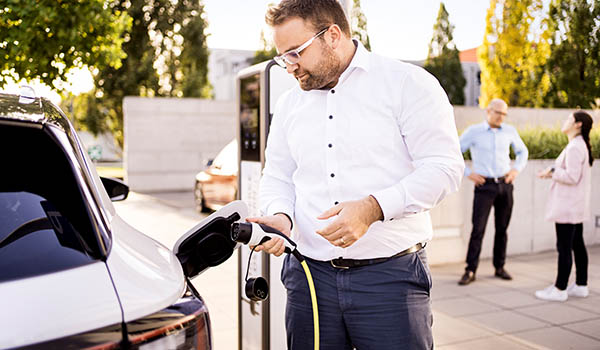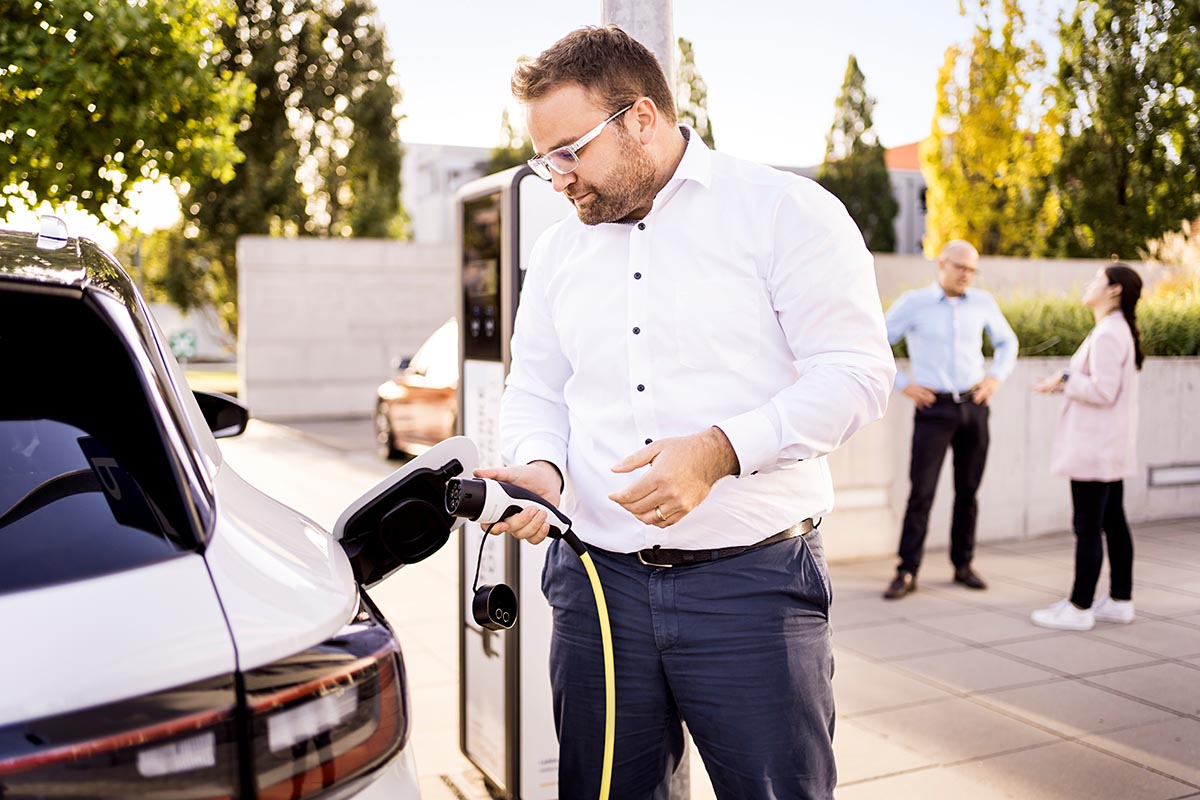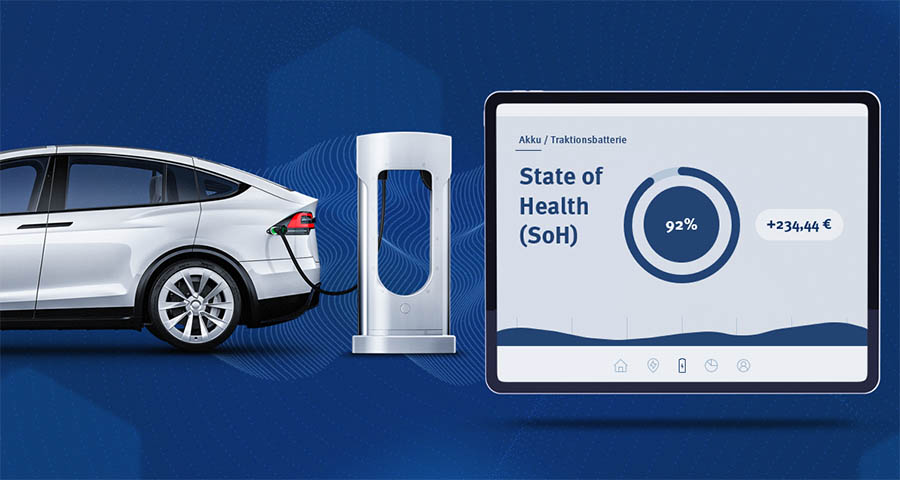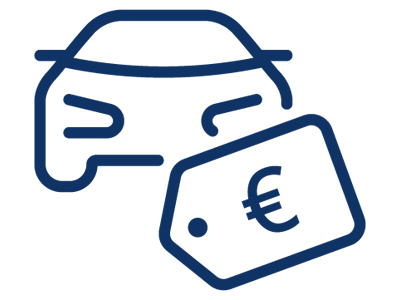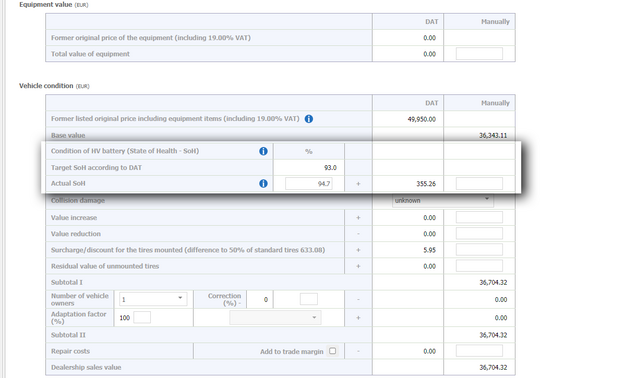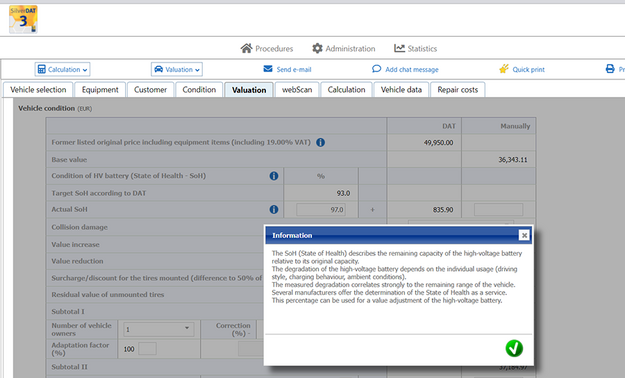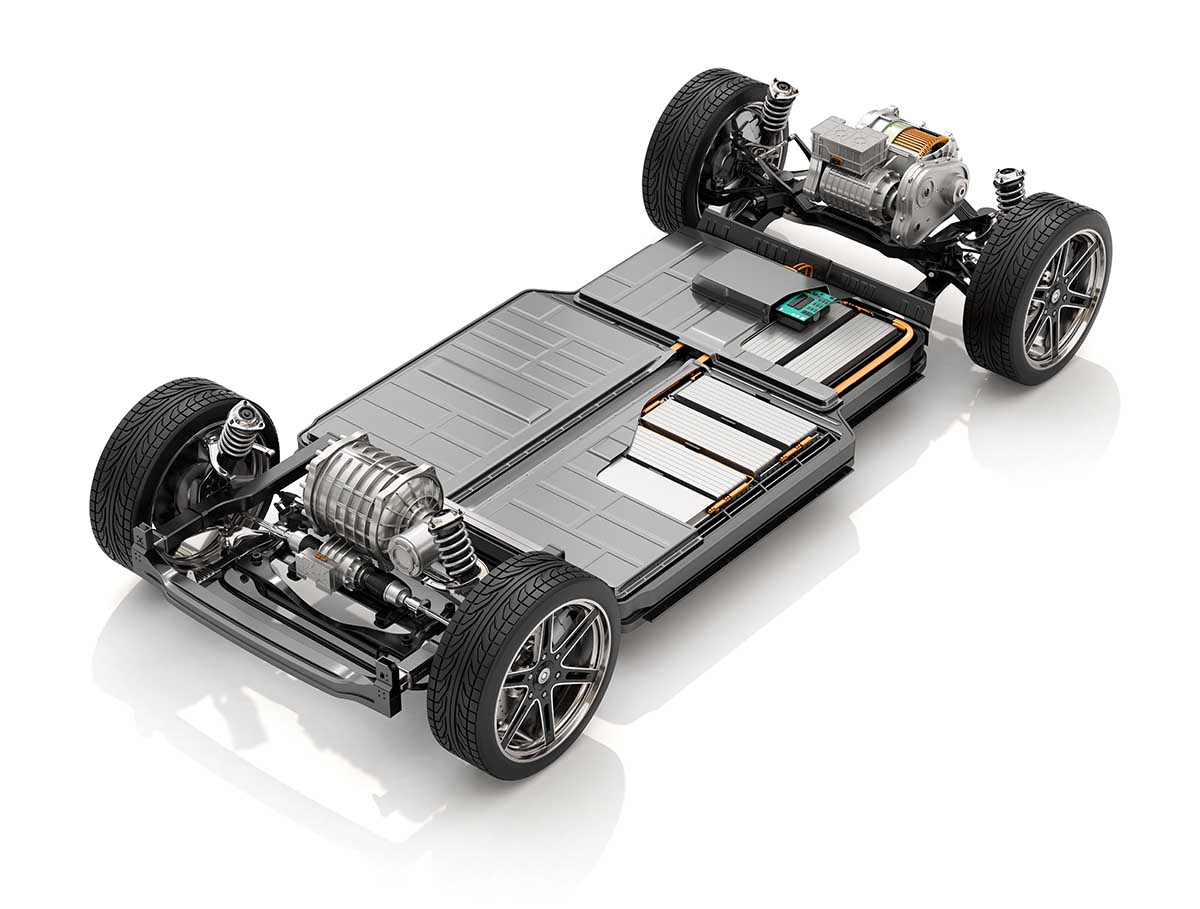Valuating used electric cars?
The same precision that you have come to expect from us.
✓ No more uncertainty when you need to calculate appropriate used vehicle prices for EVs, taking into account the battery condition
✓ No extra charges, everything included, no additional software required: the EV valuation incorporating the actual battery condition is part of the standard features of most applications from the SilverDAT valuation software product family
✓ EV leasing returns are valuated even more accurately after the end of the lease
✓ Reliable data basis for vehicle valuation with the usual DAT quality
✓ Independent SoH calculation: easily apply the results of battery tests as specified by manufacturer or alternatively/additionally using methods from independent battery diagnostics providers
How the DAT vehicle valuation for used EVs works
Battery condition, mileage, warranty conditions: which factors play a role when calculating residual value?
Right from the start, the vehicle selection in the SilverDAT 3 program interface has a lightning bolt icon to indicate that a model is an EV and you can use the expanded calculation option to work out the battery-dependent residual value for the electric vehicle. When taking into consideration the battery condition, the vehicle value is calculated based on:
- Mileage: The number of kilometres on the clock plays a key role when correcting the value for the battery.
- Vehicle age: The DAT vehicle valuation not only takes into account the year when the vehicle was first registered, but also counts every month to obtain an even more accurate result.
- State of health (SoH) / actual SoH: The measured state of health of the EV battery is given as a percentage (including one decimal place).
- Battery replacement cost: This includes the cost of replacement parts plus vehicle-specific labour costs if the EV battery needed to be replaced.
- Manufacturer's warranty conditions: Many OEMs provide guarantees, for example a minimum SoH of 70 per cent for the high-voltage battery after mileage of 160,000 km within eight years.
SilverDAT uses these parameters to calculate what SoH the EV battery should ideally have for its age and mileage. This is the target SoH according to DAT.
The SoH that is actually measured and entered in the software – the actual SoH – is compared against the saved target SoH. SilverDAT calculates any deviations between the actual SoH and target SoH directly in euros and transparently indicates how the value is corrected for this, either as a value increase or value reduction.

What software do I need to calculate the exact residual value for my EV?
... and to ensure that this residual value also takes into account the actual battery condition?
For which EV models can the residual value be calculated in relation to the actual battery condition?
The residual value calculation for EVs incorporating the actual battery condition is currently focused on fully electric vehicles, or BEVs for short (= battery electric vehicles).
Hydrogen vehicles, mild hybrids and plug-in hybrids are not yet available.
Many manufacturers and models that are also traded on the used electric vehicle market are included in the battery value correction from DAT, for example:
- Audi e-tron / e-tron GT / Q4 e-tron
- BMW i3 / i4 / i8 / iX
- Citroën E-Mehari / C-Zero / C4
- Cupra Born
- Dacia Spring Electric
- DS 3 Crossback
- Fiat 500e
- Ford Mach-E
- Genesis GV60
- Honda e
- Hyundai Ioniq 5
- Jaguar I-Pace
- Kia EV6
- Lexus UX 300e
- Mazda MX-30
- Mercedes-Benz EQA / EQS / EQE
- MG ZS EV
- Nissan Leaf
- Opel Corsa-e / Combo-e
- Peugeot e-208 / e-Rifter
- Polestar
- Porsche Taycan
- Renault Twizy / Twingo / Zoe
- Škoda Enyaq
- Smart Coupé
- Subaru Solterra
- Tesla Model S / Model 3 / Model X
- Toyota Bz4x
- Volkswagen VW e-Golf / ID.3 / ID.4 / ID.5
- Volvo XC40
This is just a selection of the EV models available for the advanced value correction. This function will be continuously expanded with many more BEVs following careful checks of the data.
Calculating the depreciation for EVs:
What exactly is a used EV battery worth?
How many euros will it cost me if the range starts dropping?
First, we need to make an important distinction: DAT does not directly calculate exactly how many euros a used EV battery is worth. Why not? There is not enough of a trade in used batteries yet. EV battery recycling needs to ramp up for this to happen. On top of this, we haven't yet seen any notable market emerge for secondary uses of used EV batteries, for example to store energy for photovoltaic systems. So the question about battery value on its own isn't very helpful.
Granted, the pure battery price means very little, but it does become clear if the EV battery capacity declines and falls below the capacity covered by the warranty – because then the manufacturer has to replace it for free. But what should you do if the battery has aged noticeably but its performance data still doesn't justify a warranty claim? How is the price of the battery calculated then?
The key question is:
What is the used EV worth with exactly this measured battery health?
... compared to an electric car with a virtually brand-new battery?
... compared to the degradation expected by the manufacturer?
... and what impact does the reduced battery life have on the vehicle's residual value?
DAT has introduced a new method for EV valuation with value correction for the battery – providing you with accurate price information for used electric vehicles which incorporates the condition of their batteries.
With this EV valuation, you can now decide which prices are justified for sale and purchase. This means no more uncertainty when you need to estimate used vehicle prices for EVs.
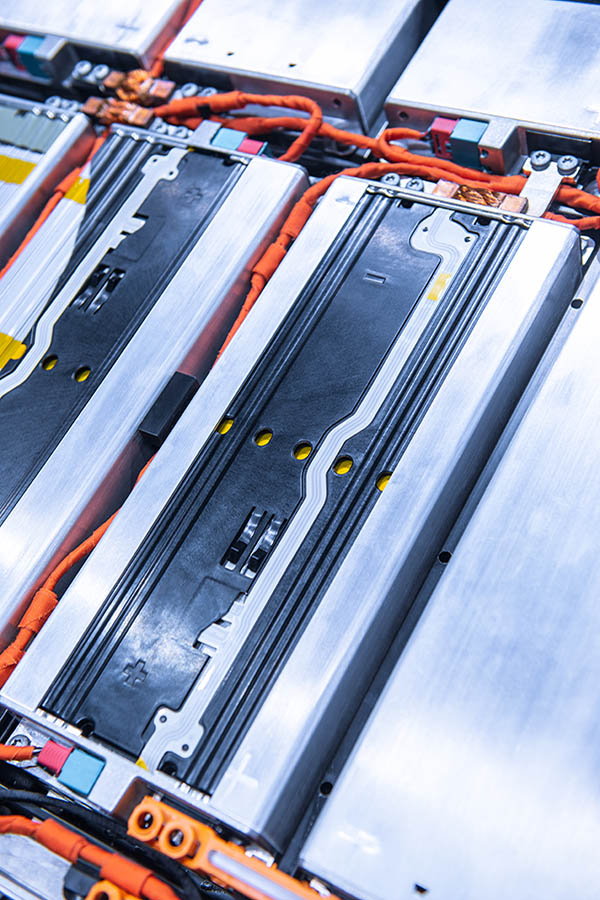
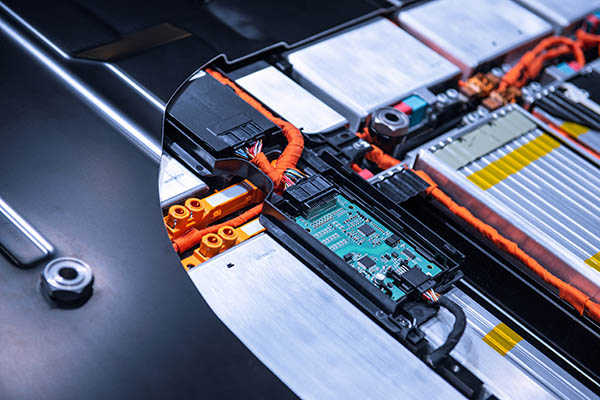
How do you work out the state of health for the EV battery?
Finding out the state of health (SoH) for the high-voltage battery: battery test and diagnostics
There are various solutions available on the market for determining the state of health (SoH) for the battery. The results can come back within a few minutes or take several hours, depending on the test method. You may need to wait several hours, for example, if a complete charging cycle is being analysed, from a fully charged to empty battery.
Or, for example, a rapid battery test from a testing organisation can take just 15 minutes to collect the data using the OBD interface on the EV. This is done first when the vehicle is stationary, and then during brief acceleration over a distance of around 100 metres. The test is based on a patented algorithm, and there are set parameters such as a battery temperature between +10 and +30°C and a battery state of charge between 40 and 80 per cent. The SoH is then displayed on the tester's smartphone along with other test results.
Another check provides information as part of a one-hour repair shop inspection. This also accesses the data via the OBD2 interface while the EV charges on a mobile charger. Algorithms estimate various battery parameters and compare the measurements against stored models. The report is then produced with the SoH figure and other parameters.
Alternatively, another test provider enables you to choose between a more comprehensive test (100 per cent state of charge is reduced to 10 per cent, test duration of up to 7 days, then send in the test box) and a rapid test (EV does not need to be moved, test takes around three minutes). This also uses the EV's OBD port to connect the test box.
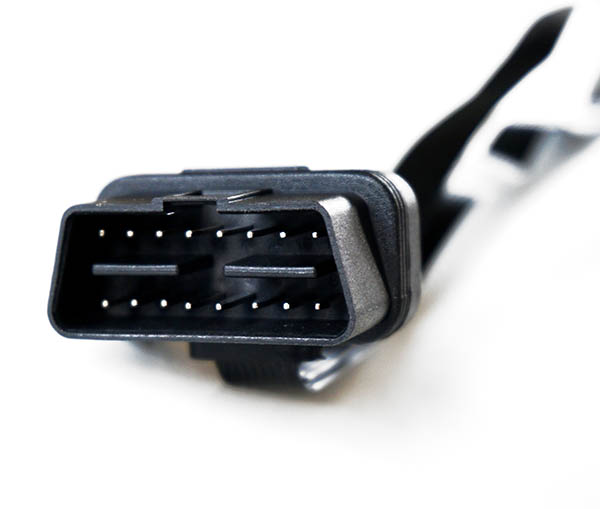
Degradation of the EV battery
How does frequent rapid charging affect the life of EV batteries?
It can't be helped: as time goes on, older batteries cannot store as much energy as new batteries. The range falls. What can help prevent this degradation? The answer is careful treatment.
If an EV battery is frequently charged on DC rapid chargers and the capacity is always used up fully, this causes greater degradation. There are two main factors that slow the degradation:
- Gentle AC charging.
- Mainly using the battery capacity between 20 and 80 per cent. This means shopping charging when the state of charge (SoC) reaches 80% and heading for a charging point when there is 20% of the range remaining.
Key factors for cyclic ageing:
- The type and frequency of charging and discharging cycles, plus the depth of discharge, charging power and temperature
- Driving behaviour, such as a sporty style and heavy, energy-intensive acceleration vs. moderate driving style
- There are chemical changes within the cell when a battery is used (= discharged) and charged. This causes thermal expansion and the formation of structures known as dendrites.
Key factors for calendar ageing:
- The time that has passed since the battery was manufactured/produced
- A battery ages over time as the electrolyte, the anode and the cathode are exposed to chemical decomposition processes
- Ageing without strain on the battery, e.g. long-term parking or parking an almost discharged EV, particularly in cold temperatures
Not a DAT customer yet? Would you like to use the EV valuation for your business?
We'd be happy to produce a custom quotation for you for SilverDAT 3
FAQ about calculating the residual value for EVs
Just like for vehicles with petrol or diesel engines, there is no one-size-fits-all answer for how much value an EV loses in general. It always depends very much on the vehicle, which needs to be individually assessed. The criteria range from mileage, wear and tear, any collision damage and depreciation for the optional and additional equipment, through to the number of previous owners.
There is one key difference between electric vehicles and other used cars: the most expensive component in these vehicles is generally the battery. The battery's state of health is a crucial factor in determining the value.
However, taking the battery into account when valuating a vehicle is a complex matter: it is not enough to factor in just the price of a replacement battery. The individual labour costs also play a role.
And this only applies for the worst-case scenario, if the battery ever needed to be replaced. An accurate and appropriate used EV valuation also needs to provide a transparent price for an old EV with a battery that has clearly aged but is still in working order and has an acceptable range. That's why the DAT valuation for used EVs takes into account the warranty conditions and the target SoH that these indicate.
To compare the depreciation of EVs against that of diesel and petrol vehicles in Germany, DAT followed three-year-old vehicles over a period of twelve months and produced percentage values for their transaction prices in the trade, compared to the previous listed original price.
The results showed record increases for used vehicle prices for three-year-old petrol and diesel cars in 2021 and 2022. The residual values increased sharply.
The situation was different for used BEVs. Their values had previously always been on a similar level to petrol cars. In Germany, the values of used BEVs fell significantly in 2021.
Why? You can read the background information in the DAT study into the ramp-up of electric mobility in Germany. You can also find out why there had been a considerable difference in the prices between battery electric vehicles (BEV) and petrol/diesel cars for a while, which is now much smaller.
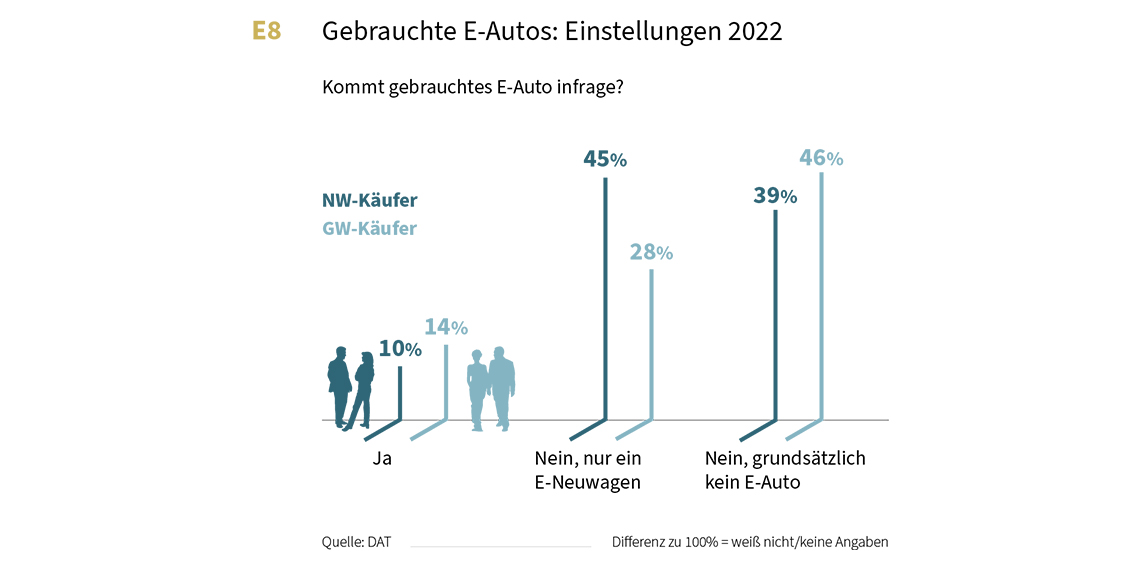
The interest in used EVs is still limited, as the DAT Report market research shows. However, the battery SoH (state of health) plays an important role for buyers.
DAT-Report | Survey: used electric cars [German language version]
The new EV value correction introduced by DAT is a DAT vehicle valuation specifically for electric vehicles (EVs).
With it, DAT is for the first time offering a standardised process for taking the battery's actual state of health (SoH) into account when valuating a vehicle.
The EV value correction considers the actually measured SoH for the battery when valuating an electric vehicle.
The following factors are considered:
- SoH (= State of Health)
- Warranty conditions
- Battery capacity
- Battery replacement cost (consisting of the cost of replacement parts and the vehicle-specific labour costs)
- Vehicle age
- Mileage
... and other factors, such as those used in the DAT vehicle valuation for cars with petrol or diesel engines.
In SilverDAT 3 you can choose whether you want to use the EV value correction option during the vehicle valuation.
With regard to Germany, the DAT market observation has found from its market analysis that the Tesla price reductions do have an impact on the used vehicle market.
There must always be a certain amount of difference between the price of a used vehicle and a new vehicle – otherwise the market doesn't work.
DAT essentially sees a risk here that the effects on the used vehicle values for Tesla models could also have a significant impact on the general price level for used EVs.
The DAT analysis, related to Germany, shows that the overall situation is complex. Unlike Tesla, other car manufacturers cannot or will not lower the prices for their new vehicles in the medium term. They may offer cheaper entry-level models with lower performance or fewer equipment items. Or they may subsidise their vehicles with cheap leasing rates, for example. However, as the costs of manufacturing an EV are still high, price reductions will always mean a significant loss of margin.
